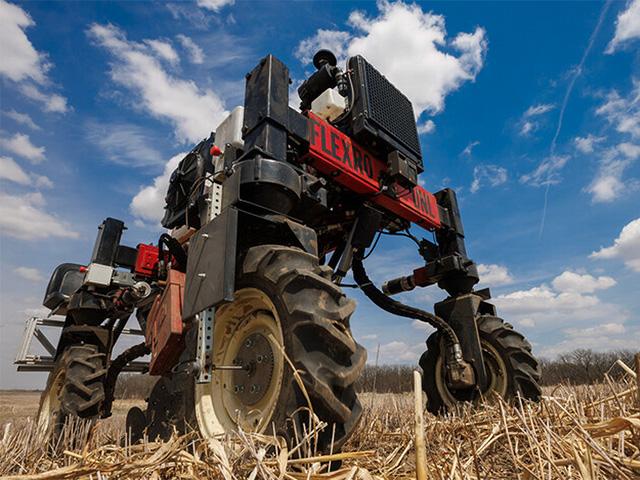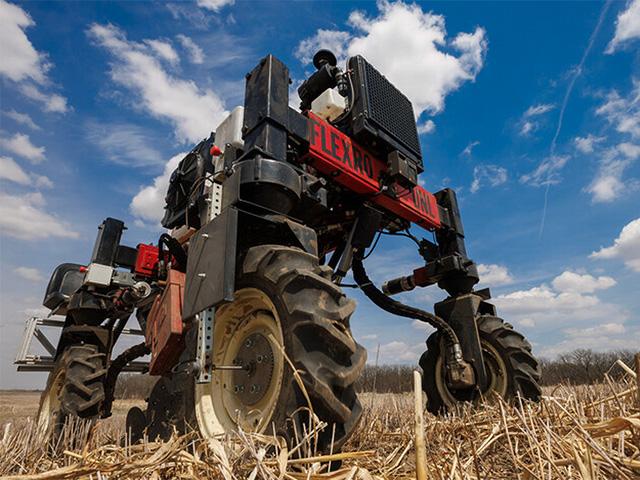MachineryLink
University of Nebraska Team Tests Flex-Ro Autonomous Planter; Deere Unveils Newest Stack-Fold Planter; CNH Hires Tech Chief
In this Equipment Roundup, DTN/Progressive Farmer looks at the University of Nebraska testing its Flex-Ro autonomous planter in April field trials; Deere offering a new 1725C CCS 12-row, 30-inch stack-fold planter; and CNH hiring a new tech chief.
**
UNIVERSITY OF NEBRASKA INTRODUCING AUTONOMOUS PLANTER
The University of Nebraska is introducing an autonomous planter that researchers there have named Flex-Ro.
A news release from the university described its work at a 5-acre no-till field on Rogers Memorial Farm one day this past April. At 2 miles per hour, and with researchers clearing obstacles from its path, the robot moved and planted on its own.
Supported by a $452,783 grant from the U.S. Department of Agriculture's National Institute of Food and Agriculture, Flex-Ro resides at the forefront of unmanned ground vehicle planter research, Santosh Pitla, associate professor of advanced machinery systems, said in the release. With the labor challenges agriculture faces, he sees robots and autonomy as a critical tool to help maintain agricultural productivity.
"I look at this robotic equipment as high-tech farm hands," he said.
The 3,800-pound machine sits on an adjustable high-clearance platform and is powered by a gas engine. Each wheel contains an electric and hydraulic motor that can be steered in four different modes.
P[L1] D[0x0] M[300x250] OOP[F] ADUNIT[] T[]
The robot, which first entered fields in 2019 to measure crop traits, can be controlled remotely and operated autonomously. Flex-Ro has been designed to be modular and reconfigurable, with different modes of steering ability available on the fly.
Ag engineering graduate student Ian Tempelmeyer has worked on this project since fall 2021. He took on the challenge of automated seeding. He spent about six months analyzing the mechanics, deciding on a design that would provide enough force to penetrate no-till soil.
"We made a quick realization that a drawn implement in a traditional manner wasn't going to work. You needed a certain downforce," he said. "We came up with the idea to put it inside the wheelbase; that's something I hadn't seen."
Making sure the equipment would run safely and smoothly required trial and error. Eventually, the engineering team, which included agricultural systems technology undergraduates Landon Sokol, Seth Chandler and Zane Rikli, refined the code and calibrated the machine enough for more sophisticated controls, such as adjusting the speed and handling terrain changes.
At the field trial in April, it took some minor adjustments to generate enough downforce, but they reached their goal of planting the whole plot with Flex-Ro.
After setting a GPS, the robot can navigate autonomously to plant, and it will stop if it meets an obstacle. It works under the mode of "supervised autonomy," meaning it still needs an operator to monitor it when planting and requires supervision when moving from one field to another.
In the coming months, Pitla's team will test unmanned aerial vehicles and unmanned ground vehicles collaboration algorithms, whereby UAVs will follow Flex-Ro to dock and transfer materials such as seeds. Their goal is to autonomously plant the full 300 acres of Rogers Memorial Farm within the next five years by using Flex-Ro robots and drones for planting, refilling the planters, spraying and applying fertilizer.
**
DEERE OFFERS NEWEST STACK-FOLD PLANTER
John Deere is offering a new 1725C CCS 12-row, 30-inch stack-fold planter along with four 1725C non-CCS planters that include 12-row/30-inch, 12-row 36-inch/38-inch, 12-row 38-inch/40-inch, or 16-row/30-inch configurations. Each 1725C planter features an enhanced John Deere designed frame with convertible hitch, giving farmers more compatibility options between various tractors fitted with a Cat 3 or 4N hitch.
The latest 1725C planters come factory equipped with ExactEmerge or MaxEmerge 5e row units, pneumatic row cleaners and closing wheels and individual-row hydraulic downforce. Farmers wanting liquid fertilizer in-furrow or off-set capabilities can add the optional ExactRate to any 1725C planter.
For information, visit www.Deere.com.
**
CNH HIRES NEW TECHNOLOGY CHIEF
CNH Industrial has appointed Friedrich Eichler as chief technology officer. He will have direct responsibility for technology, innovation, quality and design.
Eichler has more than 30 years of experience in automotive engineering with some of the world's biggest carmakers, including Volkswagen Group and Mercedes-Benz Group.
Dan Miller can be reached at dan.miller@dtn.com
Follow him on Twitter @DMillerPF
(c) Copyright 2023 DTN, LLC. All rights reserved.





Comments
To comment, please Log In or Join our Community .